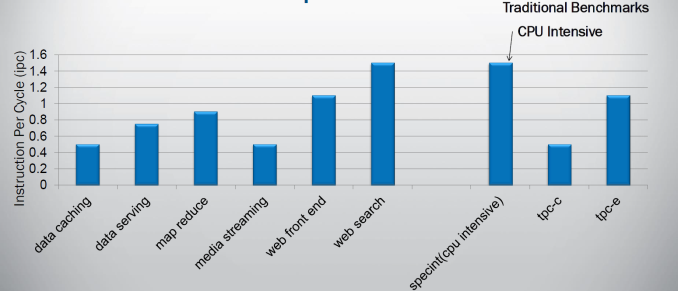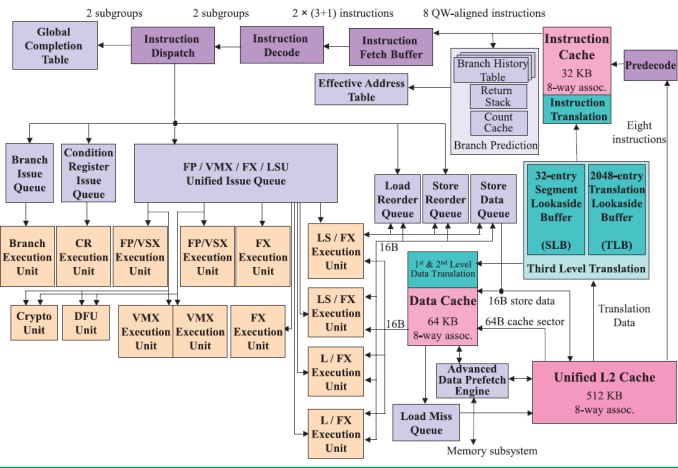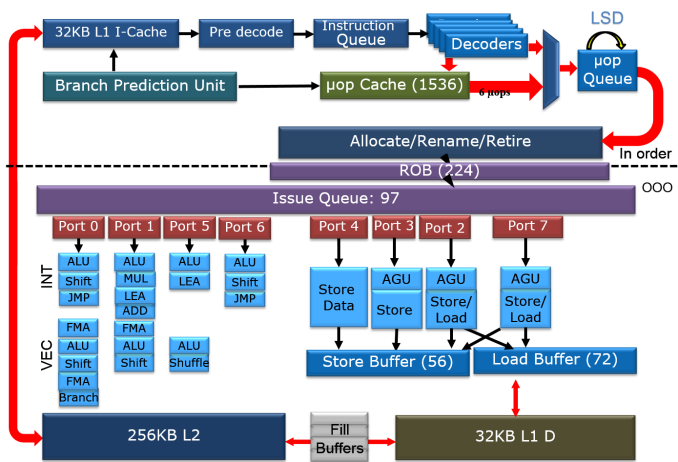Assessing IBM's POWER8, Part 1: A Low Level Look at Little Endian
by Johan De Gelas on July 21, 2016 8:45 AM ESTInside the Beast(s)
When the POWER8 was first launched, the specs were mind boggling. The processor could decode up to 8 instructions, issue 8 instructions, and execute up to 10 and all this at clockspeed up to 4.5 GHz. The POWER8 is thus an 8-way superscalar out of order processor. Now consider that
- The complexity of an architecture generally scales quadratically with the number of "ways" (hardware parallelism)
- Intel's most advanced architecture today - Skylake - is 5-way
and you know this is a bold move. If you superficially look at what kind of parallelism can be found in software, it starts to look like a suicidal move. Indeed on average, most modern CPU compute on average 2 instructions per clockcycle when running spam filtering (perlbench), video encoding (h264.ref) and protein sequence analyses (hmmer). Those are the SPEC CPU2006 integer benchmarks with the highest Instruction Per Clockcycle (IPC) rate. Server workloads are much worse: IPC of 0.8 and less are not an exception.
It is clear that simply widening a design will not bring good results, so IBM chose to run up to 8 threads simultaneously on their core. But running lots of threads is not without risk: you can end up with a throughput processor which delivers very poor performance in a wide range of applications that need that single threaded speed from time to time.
The picture below shows the wide superscalar architecture of the IBM POWER8. The image is taken from the white paper "IBM POWER8 processor core architecture", written by B. Shinharoy and many others.
The POWER8+ will have very similar microarchitecture. Since it might have to face a Skylake based Xeon, we thought it would be interesting to compare the POWER8 with both Haswell/Broadwell as Skylake.
The second picture is a very simplified architecture plan that we adapted from an older Intel Powerpoint presentation about the Haswell architecture, to show the current Skylake architecture. The adaptations were based on the latest Intel optimization manuals. The Intel diagram is much simpler than the POWER8's but that is simply because I was not as diligent as the people at IBM.
It is above our heads to compare the different branch prediction systems, but both Intel and IBM combine several different branch predictors to choose a branch. Both make use of a very large (16 K entries) global branch history table. Both processors scan 32 bytes in advance for branches. In case of IBM this is exactly 8 instructions. In case of Intel this is twice as much as it can fetch in one cycle (16 Bytes).
On the POWER8, data is fetched from the L2-cache and then predecoded into the L1-cache. Predecoding includes adding branch, exception, and grouping. This makes sure that predecoding is out the way before the actual computing ("Von Neuman Cycle") starts.
In Intel Haswell/Skylake, instructions are only predecoded after they are fetched. Predecoding performs macro-op fusion: fusing two x86 instructions together to save decode bandwidth. Intel's Skylake has 5 decoders and up to 5 µop instructions are sent down the pipelines. The current Xeon based upon Broadwell has 4 decoders and is limited to 4 instructions per clock. Those decoded instructions are sent into a µ-op cache, which can contain up to 1536 instructions (8-way), about 100 bits wide. The hitrate of the µop cache is estimated at 80-90% and up to 6 µops can be dispatched in that case. So in some situations, Skylake can run 6 instructions in parallel but as far as we understand it cannot sustain it all the time. Haswell/Broadwell are limited to 4. The µop cache can - most of the time - reduce the branch misprediction penalty from 19 to 14.
Back to the POWER8. Eight instructions are sent to the IBM POWER8 fetch buffer, where up 128 instructions can be held for two thread(s). A single thread can only use half of that buffer (64 instructions). This method of allocation gives each of two threads as much resources as one (i.e. no sharing), which is one of the key design philosophies for the POWER8 architecture.
Just like in the x86 world, the decoding unit breaks down the more complex RISC instructions into simpler internal instructions. Just like any modern Intel CPU, the opposite is also possible: the POWER8 is capable of fusing some combinations of 2 adjacent instructions into one instruction. Saving internal bandwidth and eliminating branches is one of the way this kind of fusion increases performances.
Contrary to the Intel's unified queue, the IBM POWER has 3 different issue queues: branch, condition register, and the "Load/Store/FP/Integer" queue. The first two can issue one instruction per clock, the latter can send off 8 instructions, for a combined total of 10 instructions per cycle. Intel's Haswell-Skylake cores can issue 8 µops per cycle. So both the POWER8 and Intel CPU have more than ample issue and execution resources for single threaded code. More than one thread is needed to really make use of all those resources.
Notice the difference in focus though. The Intel CPU has half of the load units (2), but each unit has twice the bandwidth (256 bit/cycle). The POWER8 has twice the amount of load units (4), but less bandwidth per unit (128 bit per cycle). Intel went for high AVX (HPC) performance, IBM's focus was on feeding 2 to 8 server threads. Just like the Intel units, the LSUs have Address Generation Units (AGUs). But contrary to Intel, the LSUs are also capable of doing simple integer calculations. That kind of massive integer crunching power would be a total waste on the Intel chip, but it is necessary if you want to run 8 threads on one core.













124 Comments
View All Comments
Michael Bay - Sunday, July 24, 2016 - link
Hardware does not exist for its own sake, it exists to run software. AT is entirely correct in their methodology.jospoortvliet - Tuesday, July 26, 2016 - link
I'd argue it is the other way around, GCC might leave 5-10% performance on the table in some niche cases but does just fine most of the time. There's a reason Intel and IBM contribute to GCC - to make sure it doesn't get too far behind as they know very well most of their customers use these compilers and not their proprietary ones.Of course, for scientific computing and other niches it makes all the difference and one can argue these heavy systems ARE for niche markets but I still think it was a sane choice to go with GCC.
abufrejoval - Thursday, August 4, 2016 - link
Actually exercising 90% of all transistors on a CPU die these days, is both very hard to do (next to impossible) and will only slow the clock to avoid overstepping TDP.And I seriously doubt that the GCC will underuse a CPU at 10% its computational capacity.
Actually from what I saw the GCC by itself (compiling) was best at exploiting the full 8T potential of the Power8. And since the GCC is compiled by itself, that speaks for the quality of machine code that it can produce, if the source allows it. And that speaks for the quality of the GCC source code, ergo prove you can do better before you rant.
abufrejoval - Thursday, August 4, 2016 - link
Well this is part 1 and describes one scenario. What you want is another scenario and of course it's a valid if a very distinct one.Actually distinct is the word here: You'd be using a vendor's compiler if your main job is a distinct workload, because you'd want to squeeze every bit of performance out of that.
The problem with that is of course, that any distinct workload makes it rather boring for the general public because they cannot translate the benchmark to their environment.
AT aims to satisfy the broadest meaningful audience and Johan as done a great, great job at that.
I'm sure he'll also write a part 4711 for you specifically, if you make it economically attractive.
Hell, even I'd do that given the proper incentive!
Zan Lynx - Sunday, July 24, 2016 - link
Using GCC as the compiler is also why (in my opinion) the Intel chips aren't using their full TDP. Large areas of Intel chips are dedicated to vector operations in SSE and AVX. If you don't issue those instructions then half the chip isn't even being used.Some gamers who love their overclocked Intel chips have actually complained to game engine developers who add AVX to the game engine. Because it ruins their overclock even if the game runs much faster. Then they're in the situation of being forced to clock down from 4.5 GHz to 3.7 in order to avoid lockups or thermal throttling.
Kevin G - Sunday, July 24, 2016 - link
The Xeon E3 v3's had different clock speeds for AVX code: it consumed too much power and got too hot while under total load.This holds true on the E5 v4's but the AVX penalty is done on a core-by-core basis, not across the entire chip. The result is improved performance in mixed workloads. This is a good thing as AVX hasn't broken out much beyond the HPC markets.
talonted - Monday, July 25, 2016 - link
For those interested in getting a Power8 workstation. Check out Talos.https://www.raptorengineering.com/TALOS/prerelease...
137ben - Monday, July 25, 2016 - link
I made an account to say that this article (along with the subsequent stock-cooler comparison article) is why I really love Anandtech. A lot of the code I run/write for my research is CPU-bottlenecked. Still, until the last year or so, I didn't know very much about hardware. Now, reading Anandtech, I have learned so much more about the hardware I depend on from this website than from any other website. Most just repeat announcements or run meaningless cursory synthetic benchmarks. The fact that Johan De Gelas has written such a deep dive into the inner workings of something as complex as a server CPU architecture, and done it in a way that I can understand, is remarkable. Great job Anandtech, keep it up and I'll always come back.JohanAnandtech - Thursday, July 28, 2016 - link
You made me a happy man, I achieved my goal :-)alpha754293 - Wednesday, July 27, 2016 - link
Excellent work and review as always Johan. I would have been interest to see how the two processors perform in floating point intensive benchmarks though...